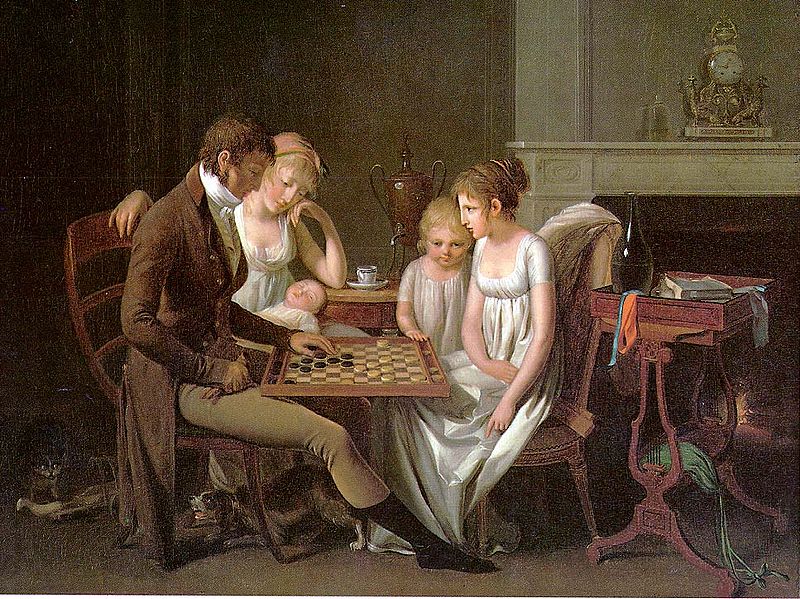Material – colored faces¶
Objectives¶
 |
In the last station we applied the material to the hole object. Now we select a few faces to color only parts of the object surface. |
Instructions¶
| Tasks: |
|---|
Create a cylinder and change the color of the top and bottom base.
Create a chessboard like in this image:

- Create an set of tokens for the game draughts (or checkers) an the board.Louis-Léopold Boilly (1761–1845)Painting of a family game of checkers(»jeu des dames«)
A colored cube¶
To be able to color of one or more faces, select them. At first the script:
#!bpy
"""
Name: 'colored_cube.py'
Blender: 2.69
Group: 'Material'
Tooltip: 'Colored faces'
"""
import bpy
red = bpy.data.materials.new('Red')
blue = bpy.data.materials.new('Blue')
yellow = bpy.data.materials.new('Yellow')
def setColor(obj, material, color):
material.diffuse_color = color
material.specular_hardness = 200
obj.data.materials.append(material)
def colored_cube():
""" A three colored cube """
bpy.ops.mesh.primitive_cube_add(location=(0,0,0))
ob = bpy.context.object
ob.name = 'three'
setColor(ob, red, (1, 0, 0))
setColor(ob, yellow, (1, 1, 0))
setColor(ob, blue, (0, 0, 1))
# apply the colors
for face in ob.data.polygons:
face.material_index = face.index % 3
if __name__ == '__main__':
bpy.ops.object.select_by_type(type='MESH')
bpy.ops.object.delete()
colored_cube()
Name the colors¶
Every color should have a name. This is the first Step.
red = bpy.data.materials.new('Red')
blue = bpy.data.materials.new('Blue')
yellow = bpy.data.materials.new('Yellow')
Add the materials¶
This is little bit tricky, to add a color for each face. Step by step:
- All faces of an object (a cube has six) are saved in a list of polygons.
- In a for loop wie iterate over this list.
- The index number from the list is divided by three with the modulo operator. So we get three possible results 0, 1 or 2.
- Each number is connected with a color.
- Finally the color number is assigned to the material index, because materials are also managed with an index.
# apply the colors
for face in ob.data.polygons:
face.material_index = face.index % 3
| hint: | In old tutorials before 2.68 faces are selected from a list named faces. Now the new list and name is polygons. |
|---|

